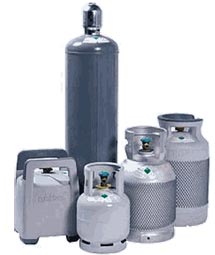Geothermal Manufacturers Converting to Chlorine-Free Refrigerants
In the US new rules come into effect on Jan. 1, 2010, restricting the use of hydrochlorofluorocarbons in refrigerants for air-conditioning systems, geothermal heat pumps and the chillers used to cool large residential and office buildings.
For years, the refrigerant of choice has been R-22, also known as HCFC-22 (short for hydrochlorofluorocarbon) or Freon 22. But R-22, when released into the atmosphere, eats away at the ozone layer, which shields the earth from hazardous ultraviolet radiation. In 1990, the US federal Clean Air Act was amended to prohibit putting newly made R-22 into equipment made after Dec. 31, 2009.
The main replacement for R-22 in residential cooling is a hydrofluorocarbon called HFC-410A. Sold under names like Puron, Genetron AZ-20 and Suva, it was recognized by the E.P.A. as an R-22 substitute in 1996.
But it's not just a matter of draining the old coolant and putting in the new. Systems must be more heavily built to accommodate the higher-pressure required by HFC-410A to make them more efficient.
 Old equipment should be disposed of with care to avoid the release of refrigerant; local jurisdictions offer guidelines.
Old equipment should be disposed of with care to avoid the release of refrigerant; local jurisdictions offer guidelines.
While HFC-410A's warming potential is lower than R-22's, to some people that is still too high,but so far, there is no widely accepted replacement for HFCs. Alternatives were already widely used in Europe and Asia but not feasible in the American market because of national and local regulatory obstacles, including building codes and safety concerns.
While many European air conditioning and refrigeration manufacturers are using natural refrigerants, North American manufacturers are cool to them. The industry here is happy with HFCs performance and are leery of investing in another costly conversion adventure for what they see as negligible return.
When the CFC phase-out was being considered, natural refrigerants were considered as a replacement, but the alternatives that were considered, such as ammonia and hydrocarbons, are flammable and toxic and in North America this led to safety concerns and litigation fears, he says. Those refrigerants were put on the back burner while HFCs became the prominent material. In Europe R&D on these fluids and their implementation were ongoing. In fact, more than 200 million refrigerators in Europe are charged with isobutane, a natural hydrocarbon refrigerant.
The natural refrigerants family includes carbon dioxide, ammonia and hydrocarbons, which can include isobutane and propane.
HFC refrigerant suppliers are aware of the Global Warming Potential (GWP) issues and a number of companies are already working to develop low-GWP refrigerant products. IDuPont and Honeywell have a joint development agreement to develop a low-GWP refrigerant for use in the automotive air conditioning industry in Europe. This same technology could also be applied eventually to stationary air conditioning and refrigeration applications.
Despite these efforts, the drumbeat to replace HFCs with natural refrigerants can be heard. Denmark passed a law that limits an HFC charge and Austria is following suit. In the U.S., California has targeted HFC emissions from cars and commercial refrigeration. According to a report by the California Air Resources Board, approximately 500,000 vending machines are in use in California that have leak rates of about 30 percent per year or about 2.7 MMTCO2 (million metric tons of carbon dioxide). These could be a target application for a low GWP refrigerant.
Perhaps the biggest push is coming from those companies that come closest to dealing with consumers such as Unilever and The Coca-Cola Company.
The Coca-Cola Company is working to phase-out HFC refrigerant-based equipment and replace it with CO2 equipment. The company is focusing on emissions from its vending machines and coolers after an audit of their carbon footprint. They looked at all of the refrigerants on the market and chose CO2 after conducting a survey analyzing the worldwide regulatory landscape. They felt that CO2 would be the best refrigerant in the long-term.
In efficiency testing, natural refrigerants did better than they initially expected, says Jacob. He says that the CO2 systems compared to the HFC systems were 4 to 7 percent better. Their testing found that CO2 systems work better at somewhat lower ambient temperatures, below 35 DegC, than did the HFC systems.
While Coca-Cola chose CO2, Unilever chose the hydrocarbon, propane. In 1994, Unilever, one of the world's biggest ice cream manufacturers, was one of the first company's to transition to HFC-based freezer cabinets and have already moved to phase these systems out. By the end of 2007, about 200,000 hydrocarbon-based freezer cabinets were installed throughout Europe. According to the company, lab tests suggest these hydrocarbon cabinets are energy efficient, using up to 12-17 percent less energy than previous units.
While the company had planned all along to phase out HFCs, it was uncertain about which natural refrigerant to choose. After testing many alternatives, they decided to back propane for a couple reasons. As an economic decision, they chose propane because at the time there were a large number of low-cost compressors on the market that could handle the natural refrigerant as compared to CO2 compliant compressors, which were not as available and cost more.
Unilever's environmental work is not just a matter of good citizenship, but economics and it may point to a new paradigm for the industry: making design and engineering decisions based on the impact of a consumer's awareness of how well a company acts as an environmental steward.
"In the early stages of the program, the consumer was less strongly in mind," says Uniliver's Alan Gerrard, "But it has become clear to us that consumers are demanding more from our products than just quality and value, they are also looking for companies that are aware of their impact on society and the environment."
Geothermal Manufacturers Converting to Chlorine-Free Refrigerants copyright 2011 Digtheheat.com
